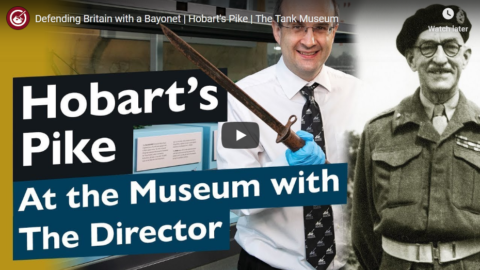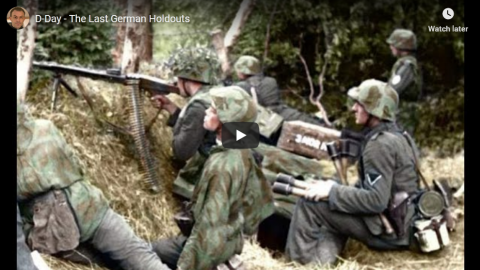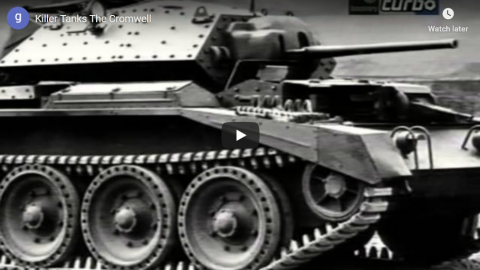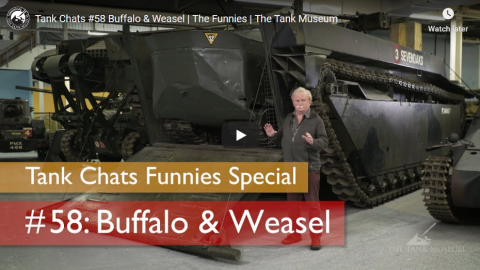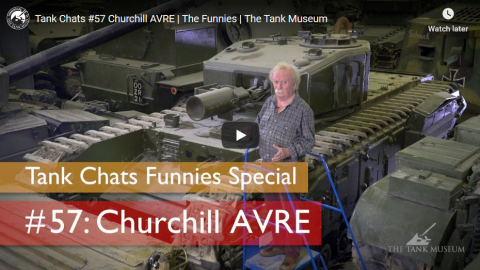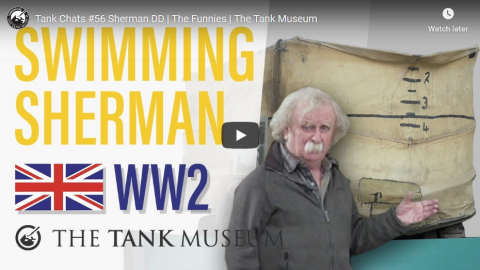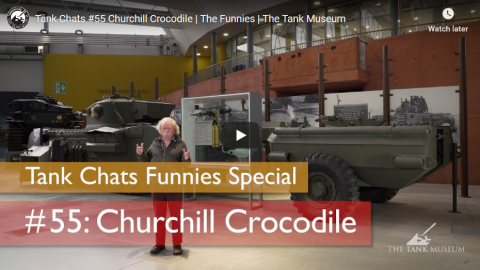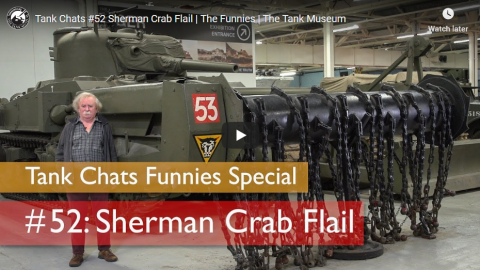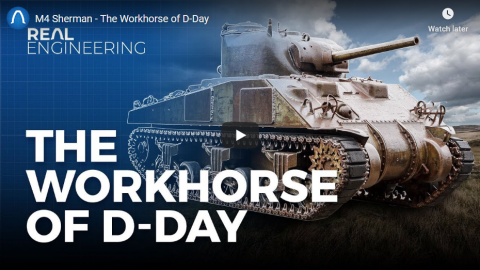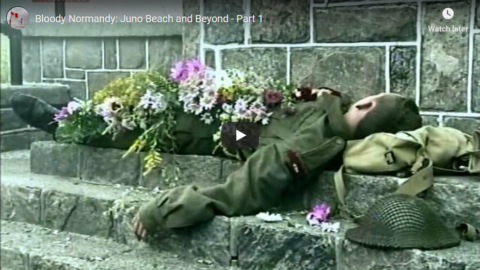The Tank Museum
Published 24 May 2020Director Richard Smith looks at Percy Hobart and the incredible weapon he was issued on joining the Home Guard at the start of WW2; a bayonet welded to a pole. Major General Percy Hobart commanded the 79th Armoured Division and gave the revolutionary, specialised tanks used on D-Day their nickname “Hobart’s Funnies”.
https://tankmuseumshop.org/
Support the work of The Tank Museum on Patreon: ► https://www.patreon.com/tankmuseum
Visit The Tank Museum SHOP & become a Friend: ► https://tankmuseumshop.org/Twitter: ► https://twitter.com/TankMuseum
Instagram: ► https://www.instagram.com/tankmuseum/
Tiger Tank Blog: ► http://blog.tiger-tank.com/
Tank 100 First World War Centenary Blog: ► http://tank100.com/
June 23, 2020
Defending Britain with a Bayonet | Hobart’s Pike | The Tank Museum
June 8, 2020
D-Day – The Last German Holdouts
Mark Felton Productions
Published 6 Jun 2020Some German coast defences managed to survive on D-Day and fought on behind Allied lines. One was the massive Douvres Radar Station bunker complex between Juno and Sword Beaches. It held out for 12 days after D-Day, and required a special operation to knock it out.
Visit my audio book channel ‘War Stories with Mark Felton’: https://youtu.be/xszsAzbHcPE
Help support my channel:
https://www.paypal.me/markfeltonprodu…
https://www.patreon.com/markfeltonpro…Disclaimer: All opinions and comments expressed in the ‘Comments’ section do not reflect the opinions of Mark Felton Productions. All opinions and comments should contribute to the dialogue. Mark Felton Productions does not condone written attacks, insults, racism, sexism, extremism, violence or otherwise questionable comments or material in the ‘Comments’ section, and reserves the right to delete any comment violating this rule or to block any poster from the channel.
Credits: YouTube Creative Commons; WikiCommons; Google Commons; Google Maps; Mark Felton Productions; Sartorlelg
May 5, 2020
Killer Tanks – The Cromwell
gusty9053
Published 12 Jul 2014
Confusingly, the tank shown in the thumbnail isn’t a Cromwell, and many later tanks are shown in footage that is supposed to be from the Dunkirk evacuation during the Battle of France in 1940 (including wrecked Churchill tanks on the beach at Dieppe in August 1942). The video covers the genesis of the tank in WW1 and the British interwar neglect of tanks, but almost completely ignores light tanks and infantry tanks to concentrate on “cruiser” tank development. Wikipedia has a useful summary of the Cromwell family of tanks:
The Cromwell tank, officially Tank, Cruiser, Mk VIII, Cromwell (A27M), was one of the series of cruiser tanks fielded by Britain in the Second World War. Named after the English Civil War leader Oliver Cromwell, the Cromwell was the first tank put into service by the British to combine high speed from a powerful and reliable engine (the Rolls-Royce Meteor), and reasonable armour. The intended dual-purpose high velocity gun could not be fitted in the turret and the medium velocity dual purpose gun fitted proved inadequate. An improved version with a high velocity gun became the Comet tank.
The name “Cromwell” was initially applied to three vehicles during development. Early Cromwell development led to the creation of the A24 Cavalier. Later Cromwell development led to the creation of the competing Tank, Cruiser, Mk VIII, Centaur (A27L) design. The Centaur tank was closely related to the Cromwell, both vehicles being externally similar. The Cromwell and Centaur tanks differed in the engine used; the Centaur had the 410 hp Liberty engine, the Cromwell had the significantly more powerful 600 hp Meteor.
The Cromwell first saw action in the Battle of Normandy in June 1944. The tank equipped the armoured reconnaissance regiments of the Royal Armoured Corps, in the 7th Armoured Division, 11th Armoured Division and the Guards Armoured Division. While the armoured regiments of the latter two divisions were equipped with M4 Shermans, the armoured regiments of the 7th Armoured Division were equipped with Cromwells. The Centaurs were not used in combat except for those fitted with a 95 mm howitzer, which were used in support of the Royal Marines during the amphibious invasion of Normandy.
[…]
Post war
After the war, the Cromwell remained in British service, and saw service in the Korean War with the 8th King’s Royal Irish Hussars.
Cromwell Tanks were used by Czechoslovakia and Israel.
Fifty-two Centaur I tanks were donated in early 1946 to the Greek Army, during the opening stages of the Greek Civil War but they were kept in storage due to the lack of trained personnel. In 1947, the first Greek officers returned from training courses in the United Kingdom and training of tank crews began. In April 1948, the Centaurs were organised in three Centaur tank companies initially numbered II, IX and XI, but a year later were renumbered 381, 382, 383 and temporarily attached to Reconnaissance Regiments 391, 392, and 393. The Centaurs saw limited service in the war because battles were fought mainly on mountainous areas, but proved useful in supporting infantry units and in defence of inhabited areas. After the end of the war, in October 1949, the three Centaur companies were organised into the 391 Tank Regiment. The Centaurs were replaced by US built M47s and in 1962 were sold and scrapped. One Centaur is preserved in the Greek Army Tank Museum.
The British army, Austria and Jordan used the upgraded Charioteer version of the Cromwell post-war. Jordanian vehicles saw action in conflicts in the Middle-East.
January 10, 2020
Tank Chats #58 Buffalo & Weasel | The Funnies | The Tank Museum
The Tank Museum
Published 28 Oct 2018Another episode in the Tank Chats Funnies Specials, with David Fletcher looking at the weird and wonderful vehicles of 79th Armoured Division led by Major General Percy Hobart, known as “Hobart’s Funnies”.
The Buffalo, or Landing Vehicle Tracked IV (LVT), is a lightly armoured tracked amphibious carrier. British “Buffaloes” were used in Northern Italy during WW2 and were issued to the 79th Armoured Division in Northwest Europe where they played an important role in the crossing of the Rhine, in 1945. This particular Weasel is amphibious and was used in muddy and wet conditions, rather than directly in water.
Support the work of The Tank Museum on Patreon: ► https://www.patreon.com/tankmuseum
Visit The Tank Museum SHOP: ► https://tankmuseumshop.org/
Twitter: ► https://twitter.com/TankMuseum
Tiger Tank Blog: ► http://blog.tiger-tank.com/
Tank 100 First World War Centenary Blog: ► http://tank100.com/ #tankmuseum #tanks #tankchats
January 2, 2020
Tank Chats #57 Churchill AVRE | The Funnies | The Tank Museum
The Tank Museum
Published 20 Sep 2018Another episode in the Tank Chats Funnies Specials, with David Fletcher looking at the weird and wonderful vehicles of 79th Armoured Division led by Major General Percy Hobart, known as “Hobart’s Funnies”.
The Churchill AVRE (Armoured Vehicle Royal Engineers). The Churchill was the basis for a number of Funnies. David Fletcher looks at the Fascine, Bobbin, Small Box Girder bridge, Bullshorn plough, Conger, the Churchill ARK and Bridgelayer.
Support the work of The Tank Museum on Patreon: ► https://www.patreon.com/tankmuseum
Or donate http://tankmuseum.org/support-us/donateVisit The Tank Museum SHOP: ► https://tankmuseumshop.org/
Twitter: ► https://twitter.com/TankMuseum
Tiger Tank Blog: ► http://blog.tiger-tank.com/
Tank 100 First World War Centenary Blog: ► http://tank100.com/ #tankmuseum #tanks #tankchats
December 1, 2019
Tank Chats #56 Sherman DD | The Funnies | The Tank Museum
The Tank Museum
Published 7 Sep 2018Another episode in the Tank Chats Funnies Specials, with David Fletcher looking at the weird and wonderful vehicles of 79th Armoured Division led by Major General Percy Hobart, known as “Hobart’s Funnies”.
The Sherman DD, or Duplex Drive, was a term applied to Sherman tanks modified for amphibious operations. DD tanks were used by American, British and Canadian forces in WW2 on D-Day, 6 June 1944; by the Americans again in the south of France and by the Americans and British during the Rhine crossing.
Support the work of The Tank Museum on Patreon: ► https://www.patreon.com/tankmuseum
Or donate http://tankmuseum.org/support-us/donateVisit The Tank Museum SHOP: ► https://tankmuseumshop.org/
Twitter: ► https://twitter.com/TankMuseum
Tiger Tank Blog: ► http://blog.tiger-tank.com/
Tank 100 First World War Centenary Blog: ► http://tank100.com/ #tankmuseum #tanks #tankchats
November 26, 2019
Tank Chats #55 Churchill Crocodile | The Funnies | The Tank Museum
The Tank Museum
Published 18 Aug 2018Another episode in the Tank Chats Funnies Specials, with David Fletcher looking at the weird and wonderful vehicles of 79th Armoured Division led by Major General Percy Hobart, known as “Hobart’s Funnies”.
The Churchill Crocodile was a British flamethrower tank and a variant of the Churchill Mark VII tank. The Crocodile was developed in time for the D-Day landings and used during the Allied invasion of North-West Europe.
Support the work of The Tank Museum on Patreon: ► https://www.patreon.com/tankmuseum
Or donate http://tankmuseum.org/support-us/donateVisit The Tank Museum SHOP: ► https://tankmuseumshop.org/
Twitter: ► https://twitter.com/TankMuseum
Tiger Tank Blog: ► http://blog.tiger-tank.com/
Tank 100 First World War Centenary Blog: ► http://tank100.com/ #tankmuseum #tanks #tankchats
October 13, 2019
Tank Chats #52 Sherman Crab Flail | The Funnies | The Tank Museum
The Tank Museum
Published on 15 Jun 2018Tank Chats playlist https://www.youtube.com/playlist?list…
Another episode in the Tank Chats Funnies Specials, looking at the weird and wonderful vehicles of 79th Armoured Division led by Major General Percy Hobart.
The Flail tank was designed to clear mines and flails were operated in the 79th Armoured Division after D-Day.
Support the work of The Tank Museum on Patreon: ► https://www.patreon.com/tankmuseum
Or donate http://tankmuseum.org/support-us/donateVisit The Tank Museum SHOP: ►https://tankmuseumshop.org/
Press the little bell above to enable NOTIFICATIONS so you don’t miss the latest Tank Museum videos.
Twitter: ► https://twitter.com/TankMuseum
Tiger Tank Blog: ► http://blog.tiger-tank.com/
Tank 100 First World War Centenary Blog: ► http://tank100.com/ #tankmuseum #tanks #tankchats
September 23, 2019
M4 Sherman – The Workhorse of D-Day
Real Engineering
Published on 21 Sep 2019Watch over 2,400 documentaries for free for 30 days by signing up at http://www.CuriosityStream.com/realen… and using the code, “
realengineering”New streaming platform: https://watchnebula.com/
Patreon:
https://www.patreon.com/user?u=282505…
Twitter:
https://twitter.com/thebrianmcmanus
Discord:
https://discord.gg/s8BhkmNThank you to AP Archive for access to their archival footage
August 27, 2019
The Secret Invention That Made D-Day Possible | INTEL
Forces TV
Published on 7 Jun 2019As much as the success of D-Day was down to the bravery of soldiers … it was made possible by inventions and new machines. These Mulberry Harbours were a real World War 2 engineering victory.
More Mulberry: https://www.forces.net/d-day/mulberry-harbours-how-allies-floated-concrete-win-d-day
Forces Net D-Day Hub: http://forces.net/dday
June 7, 2019
The almost-forgotten 1st Canadian Parachute Battalion on D-Day
Colby Cosh reminds us that Canadian troops landed in Normandy in at least one other location than on Juno Beach:
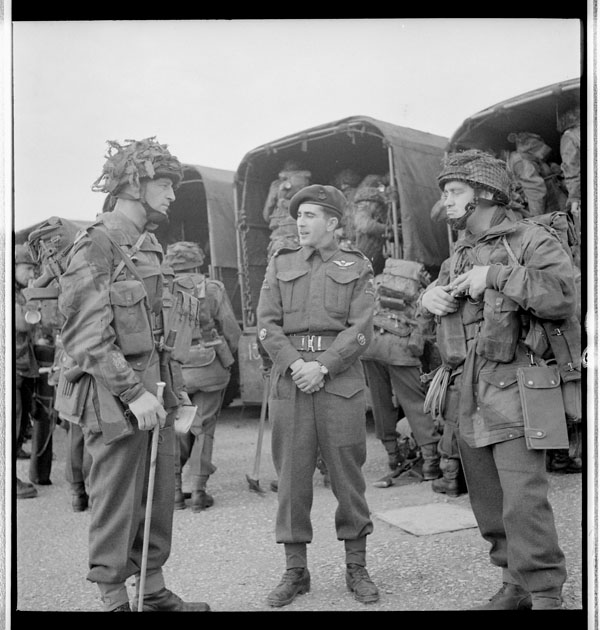
From left to right, Regimental Sergeant-Major “Knobby” Clark, Company Sergeant-Major Norbert Joseph and Company Sergeant-Major Outhwaite of the 1st Canadian Parachute Battalion getting ready to leave Carter Barracks for their D-Day transit camp, May 1944.
Canada. Dept. of National Defence / Library and Archives Canada / e002852749
Col. C.P. Stacey’s 1946 history of 1st Canadian Parachute Battalion in Normandy describes the expectations of high command chillingly. For the purposes of the invasion, the Canadians operated as a component of the British 6th Airborne Division, assigned to blow up bridges, seize crossroads and establish advance observation posts deep in enemy territory. The War Office estimated, Stacey wrote, “that the wastage for the first month would be at the double intense rate, i.e., 50 per cent of War Establishment for officers and 40 per cent for other ranks.”
With regard to the Canadian airborne, this accounting proved largely accurate: 541 men from the battalion left England to be dropped into the battle of Normandy, the enumerated casualties for June 6 alone were two “presumed killed,” 18 dead, six wounded, and 81 taken prisoner. The unit lost no more to capture after the first day, but by June 17, when the battalion was removed from the front line for the first time, the other categories had swelled to 48 killed and 113 wounded. Stacey’s calculation of the actual “wastage” rate is that it was 59 per cent for officers and 39 per cent for other ranks.
If you have read about the paras, it is perhaps not the casualty figures that strike you so much as the unique Gothic horror of their particular experience of D-Day. The Americans’ use of parachute attacks in Sicily had taught planners that putting soldiers right on the intended drop zone never went as well as in training. Pilots who were comfortable flying slow and at suitable height over Fort Benning inevitably found themselves less cool over enemy terrain dotted with anti-aircraft guns and small arms.
In some cases evasive manoeuvres flung the airborne infantry out of the hatch without warning. Meanwhile, flat areas that had looked like green fields in photos turned out to be algae-covered swamps, some intentionally flooded by the Germans. Anyone who had volunteered for the paratroops in the hope of avoiding drowning could be in for a dreadful surprise. The historian Dan Hartigan, son of a 1st Battalion vet of the same name, describes a close shave for Sgt. W.R. Kelly, later killed in the Battle of the Bulge. “One man found Sergeant Kelly hanging upside down with his head in the water, from a huge deadwood tree. … The canopy had caught on a limb and suspended Kelly so he was submerged from the top of his head to his neck.” Kelly was rescued by a nearby comrade, but some soldiers in similar predicaments dropped alone and were not so lucky. In darkness and confusion, others landed badly, broke limbs, and were out of action at once.
June 6, 2019
On D-Day what did the Germans know?
Military History Visualized
Published on 28 May 2019When it comes to D-Day and the German perspective there are a few bits out there, but the sources are sometimes lacking. So, for this, we will be looking at some proper sources namely, the situation report of Operations Staff of the Wehrmacht and the war diary of the 7th German Army.
Cover design by vonKickass.
»» SUPPORT MHV ««
» paypal donation – https://paypal.me/mhvis
» patreon – https://www.patreon.com/mhv» SOURCES «
Mehner, Kurt (Hrsg.): Die geheimen Tagesberichte der Deutschen Wehrmachtführung im Zweiten Weltkrieg 1939-1945. Band 10: 1. März 1944 – 31. August 1944, Biblio Verlag: Osnabrück, 1985.
Schramm, Percy E.: (Hrsg.): Kriegstagebuch des OKW 1944-1945. Teilband I. Eine Dokumentation. Bechtermünz: 2005.
Lieb, Peter: Unternehmen Overlord. Die Invasion in der Normandie und die Befreiung Westeuropas. C.H. Beck: München, 2014.
Horst Boog, Gerhard Krebs, Detlef Vogel: Das Deutsche Reich und der Zweite Weltkrieg. Band 7. Das Deutsche Reich in der Defensive – Strategischer Luftkrieg in Europa, Krieg im Westen und in Ostasien 1943 bis 1944/45, Deutsche Verlags-Anstalt, Stuttgart 2001.
Germany and the Second World War. Volume 7. The Strategic Air War in Europe and the War in the West and East Asia 1943–1944/5. 2006.
Citino, Robert M.: The Wehrmacht’s Last Stand. The German Campaigns of 1944-1945. University Press of Kansas: USA, 2017.
Fennell, Jonathan: Fighting the People’s War. The British and Commonwealth Armies and the Second World War. Cambridge University Press: Cambridge, UK, 2019
Harrison, Gordon A.: Cross-Channel Attack. United States army in World War II. Center of Military History, United States Army, Washington D.C., 1993
Blumenson, Martin: Breakout and Pursuit. United States army in World War II. Center of Military History, United States Army, Washington D.C., 1993
Messenger, Charles: The D-Day Atlas. Anatomy of the Normandy Campaign, Thames & Hudson: London, 2014 (2004).
Penrose, Jane (ed.): The D-Day Companion. Leading Historians explore history’s greatest amphibious assault. Osprey Publishing: Oxford 2009 (2004).
Töppel, Roman: Kursk 1943. The Greatest Battle of the Second World War. Helion: Warwick, UK: 2018.
Document for June 6th: D-day statement to soldiers, sailor, and airmen of the Allied Expeditionary Force, 6/44 https://www.archives.gov/global-pages…
The Invasion of France, June 6, 1944, House of Commons https://winstonchurchill.org/resource…
Bloody Normandy: Juno Beach and Beyond – Part 1
canmildoc
Published on 17 Sep 2011Part 1 of 5
Documentary “Stories from the Second World War: Bloody Normany”.
Juno or Juno Beach was one of five sectors of the Allied invasion of German-occupied France in the Normandy landings on 6 June 1944, during the Second World War. The sector spanned from Saint-Aubin, a village just east of the British Gold sector, to Courseulles, just west of the British Sword sector. The Juno landings were judged necessary to provide flanking support to the British drive on Caen from Sword, as well as to capture the German airfield at Carpiquet west of Caen. Taking Juno was the responsibility of the 3rd Canadian Infantry Division and commandos of the Royal Marines, with support from Naval Force J, the Juno contingent of the invasion fleet, including ships of the Royal Canadian Navy (RCN). The beach was defended by two battalions of the German 716th Infantry Division, with elements of the 21st Panzer Division held in reserve near Caen.
The invasion plan called for two brigades of the 3rd Canadian Division to land in two subsectors — Mike and Nan — focusing on Courseulles, Bernières, and Saint-Aubin. It was hoped that preliminary naval and air bombardment would soften up the beach defences and destroy coastal strongpoints. Close support on the beaches was to be provided by amphibious tanks of the 2nd Canadian Armoured Brigade. Once the landing zones were secured, the plan called for the 9th Canadian Infantry Brigade to land reserve battalions and deploy inland, the Royal Marine commandos to establish contact with the British 3rd Infantry Division on Sword, and the 7th Canadian Infantry Brigade to link up with the British 50th (Northumbrian) Infantry Division on Gold. The 3rd Canadian Division’s D-Day objectives were to capture Carpiquet Airfield and reach the Caen-Bayeux railway line by nightfall.
The landings initially encountered heavy resistance from the German 716th Division; the preliminary bombardment proved less effective than had been hoped, and rough weather forced the first wave to be delayed until 07:35. Several assault companies — notably those of the Royal Winnipeg Rifles and The Queen’s Own Rifles of Canada — took heavy casualties in the opening minutes of the first wave. Strength of numbers, as well as coordinated fire support from artillery and armoured squadrons, cleared most of the coastal defences within two hours of landing. The reserves of the 7th and 8th brigades began deploying at 08:30 (along with the Royal Marines), while the 9th Brigade began its deployment at 11:40.
The subsequent push inland towards Carpiquet and the Caen-Bayeux railway line achieved mixed results. The sheer numbers of men and vehicles on the beaches created lengthy delays between the landing of the 9th Brigade and the beginning of substantive attacks to the south. The 7th Brigade encountered heavy initial opposition before pushing south and making contact with the 50th Infantry Division at Creully. The 8th Brigade encountered heavy resistance from a battalion of the 716th at Tailleville, while the 9th Brigade deployed towards Carpiquet early in the evening. Resistance in Saint-Aubin prevented the Royal Marines from establishing contact with the British 3rd Division on Sword. When all operations on the Anglo-Canadian front were ordered to halt at 21:00, only one unit had reached its D-Day objective, but the 3rd Canadian Infantry Division had succeeded in pushing farther inland than any other landing force on D-Day. – http://en.wikipedia.org/wiki/Juno_beach
QotD: Reviewing Saving Private Ryan
When Saving Private Ryan was released in America, I made a mild observation to the effect that its premise was a lot of hooey, and received in response several indignant letters pointing out that it was “based on a true story”, that of the Sullivan brothers. Er, not quite. The Sullivans’ story is stirringly told in The Fighting Sullivans (1942, directed by 42nd Street’s Lloyd Bacon): after Pearl Harbor, all five brothers enlist — and all five die aboard the [cruiser] Juneau at Guadalcanal. As a result, to avoid the recurrence of such a freakish tragedy, the United States changed its policy on family members serving together. Steven Spielberg’s film is not “based” on the Sullivans, except insofar as General George C. Marshall, the US Army’s chief of staff, mentions their fate to explain his decision.
Rather, the film is a kind of extension of the thinking behind the policy change: when three out of four Ryan brothers are killed in action, General Marshall orders a rescue mission to retrieve the sole surviving sibling, whose general whereabouts are somewhere behind enemy lines in Normandy — and all this a couple of days after D-Day. No such incident took place: no Allied commander would have thought it worth the risk in lives to assuage one distraught mother’s potential further bereavement.
Spielberg’s mistake is that, as one of the last remaining hardcore Clinton groupies, he’s thinking in Clintonian terms — about publicity, image, spin: the death of another Ryan brother would not “look good”. When Spielberg has General Marshall read out a letter from Lincoln to a mother whose sons all died in the Civil War, we’re certainly meant to find his consoling words — that they gave their lives in a great and noble cause — inadequate. It’s a measure of the gulf between 1944 and 1998 that The Fighting Sullivans was released during the war because it was thought the supreme sacrifice of one family would be inspiring. Alas, not to baby boomers.
So much has been written about the unprecedented “realism” of this film’s war scenes that the equally unprecedented unrealism of its thinking has passed virtually unnoticed. You’ve probably seen a zillion articles about the film’s prologue — a recreation of D-Day which lasts almost as long and doubtless cost a lot more — so I’ll say only this: yes, it’s impressive; yes, every shot of blood and tissue and body parts is underlined by adroit effects; yes, every moment is a testament to Spielberg’s command of cinematic technique; but that’s the problem — you react to it as technique, as showmanship. There’s one perfect shot after another: the silence underwater, with its dangerous illusion of respite; the pitterpatter of rain on leaves gradually blurring into rifle fire. The whole thing is oddly pointless: you’re not engaged by the predicament of the troops because you’re so busy admiring the great film-maker behind them. A film cannot really be “authentic” if all you notice is the authenticity.
Mark Steyn, The Spectator, 1998-09-12 (linked from SteynOnline).
April 3, 2019
Tank Chats #45 Major General Sir Percy Hobart | The Funnies | The Tank Museum
The Tank Museum
Published on 10 Feb 2018Welcome to the first in the Tank Chat Funnies mini-series!
In Tank Chats #45 David begins a series on one of his personal interests, the Funnies of the 79th Armoured Division. However the 79th and its Funnies would have been nothing without its inspirational leader Major General Percy Hobart, so David starts with the man and we promise will follow very shortly with his machines.
Support the work of The Tank Museum on Patreon: ► https://www.patreon.com/tankmuseum
Or donate http://tankmuseum.org/support-us/donateVisit The Tank Museum SHOP: ►https://tankmuseumshop.org/
Press the little bell above to enable NOTIFICATIONS so you don’t miss the latest Tank Museum videos.
Twitter: ► https://twitter.com/TankMuseum
Tiger Tank Blog: ► http://blog.tiger-tank.com/
Tank 100 First World War Centenary Blog: ► http://tank100.com/ #tankmuseum #tanks

